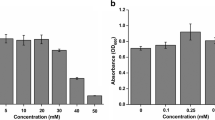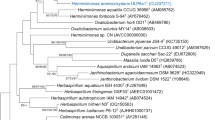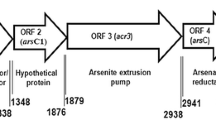Abstract
Arsenic resistance in the acidophilic iron-oxidizing archaeon "Ferroplasma acidarmanus" was investigated. F. acidarmanus is native to arsenic-rich environments, and culturing experiments confirm a high level of resistance to both arsenite and arsenate. Analyses of the complete genome revealed protein-encoding regions related to known arsenic-resistance genes. Genes encoding for ArsR (arsenite-sensitive regulator) and ArsB (arsenite-efflux pump) homologues were found located on a single operon. A gene encoding for an ArsA relative (anion-translocating ATPase) located apart from the arsRB operon was also identified. Arsenate-resistance genes encoding for proteins homologous to the arsenate reductase ArsC and the phosphate-specific transporter Pst were not found, indicating that additional unknown arsenic-resistance genes exist for arsenate tolerance. Phylogenetic analyses of ArsA-related proteins suggest separate evolutionary lines for these proteins and offer new insights into the formation of the arsA gene. The ArsB-homologous protein of F. acidarmanus had a high degree of similarity to known ArsB proteins. An evolutionary analysis of ArsB homologues across a number of species indicated a clear relationship in close agreement with 16S rRNA evolutionary lines. These results support a hypothesis of arsenic resistance developing early in the evolution of life.






Similar content being viewed by others
References
Alpers CN, Nordstrom DK, Thompson JM (1994) Seasonal variations of Zn/Cu ratios in acid mine water from Iron Mountain, California. In: Alpers CN, Blows DW (eds) Environmental geochemistry of sulfide oxidation. American Chemical Society, Washington, DC, pp 324–344
Altschul SF, Madden TL, Schaffer AA, Zhang JH, Miller W, Lipman DJ (1997) Gapped BLAST and PSI-BLAST: a new generation of protein database search programs. Nucleic Acids Res 25:3389–3402
Bhattacharjee HJ, Li J, Ksenzenko MY, Rosen BP (1995) Role of cysteinyl residues in metalloactivation of the oxyanion-translocating ArsA ATPase. J Biol Chem 270:11245–11250
Butcher BG, Deane SM, Rawlings DE (2000) The chromosomal arsenic resistance genes of Thiobacillus ferrooxidans have an unusual arrangement and confer increased arsenic and antimony resistance to Escherichia coli. Appl Environ Microbiol 66:1826–1833
Carlin A, Shi W, Dey S, Rosen BP (1995) The ars operon of Escherichia coli confers arsenical and antimonal resistance. J Bacteriol 177:981–986
Cervantes C, Ji G, Ramírez JL, Silver S (1994) Resistance to arsenic compounds in microorganisms. FEMS Microbiol Rev 15:355–367
Chen Y, Rosen BP (1997) Metalloregulatory properties of the ArsD repressor. J Biol Chem 272:14257–14262
Chen C, Misra TK, Silver S, Rosen BP (1986) Nucleotide sequence of the structural genes for an anion pump. The plasmid-encoded arsenical resistance operon. J Biol Chem 261:15030–15038
Dagnac T, Padró A, Rubio R, Rauret G (1999) Speciation of arsenic in mussels by the coupled system liquid chromatography—UV irradiation—hydride generation—inductively coupled plasma mass spectrometry. Talanta 48:763–772
Diorio C, Cai J, Marmor J, Shinder R, DuBow MS (1995) An Escherichia coli chromosomal ars operon homolog is functional in arsenite detoxification and is conserved in gram-negative bacteria. J Bacteriol 177:2050–2056
Edwards, KJ, Schrenk MO, Hamers R, Banfield JF (1998) Microbial oxidation of pyrite: experiments using microorganisms from an extreme acidic environment. Am Miner 83:1444–1453
Edwards KJ, Bond PL, Gihring TM, Banfield JF (2000) An archaeal iron-oxidizing extreme acidophile important in acid mine drainage. Science 287:1796–1799
Gladysheva TB, Oden KL, Rosen BP (1994) Properties of the arsenate reductase of plasmid R773. Biochemistry 33:7288–7293
Klaue B, Blum JD (1999) Trace analysis of arsenic in drinking water by inductively coupled plasma mass spectrometry: high resolution versus hydride generation. Anal Chem 71:1408–1414
Li J, Rosen BP (2000) The linker peptide of the ArsA ATPase. Mol Microbiol 35:361–367
Li J, Liu S, Rosen BP (1996) Interaction of ATP binding sites in the ArsA ATPase, the catalytic subunit of the Ars pump. J Biol Chem 271:25247–25252
McGuire MM, Edwards KJ, Banfield JF, Hamers RJ (2001) Kinetics, surface chemistry, and structural evolution of microbially mediated sulfide mineral dissolution. Geochim Cosmochim Acta 65:1243–1258
Ng WV, Ciufo SA, Smith TM, Bumgarner RE, Baskin D, Faust J, Hall B, Loretz C, Seto J, Slagel J, Hood L, DasSarma S (1998) Snapshot of a large dynamic replicon in a halophilic archaeon: megaplasmid or minichromosome? Genome Res 8:1131–1141
Peters S (2001) The origins and geochemical behavior of arsenic in a fractured bedrock aquifer, New Hampshire. Ph.D. Dissertation, University of Michigan
Rensing C, Ghosh M, Rosen BP (1999) Families of soft-metal-ion-transporting ATPases. J Bacteriol 181:5891–5897
Rosen BP (1999) Families of arsenic transporters. Trends Microbiol 7:207–212
Saha JC, Dikshit AK, Bandyopadhyay M, Saha KC (1999) A review of arsenic poisoning and its effects on human health. Crit Rev Environ Sci Technol 29:281313
Shi WP, Dong J, Scott RA, Rosen BP (1996) The role of arsenic-thiol interactions in metalloregulation of the ars operon. J Biol Chem 271:9291–9297
Silver S (1996) Bacterial resistances to toxic metal ions—a review. Gene 197:9–19
Smith RF, Smith TF (1990) Automatic generation of primary sequence patterns from sets of related protein sequences. Proc Natl Acad Sci USA 87:118–122
Smith RF, Smith TF (1992) Pattern-induced multi-sequence alignment (PIMA) algorithm employing secondary structure-dependent gap penalties for comparative protein modelling. Protein Eng 5:35–41
United States Environmental Protection Agency (2001) National Primary Drinking Water Standards. EPA 816-F-01–007
Wei X, Brockhoff-Schwegel CA, Creed JT (2001) A comparison of urinary arsenic speciation via direct nebulization and on-line photo-oxidation-hydride generation with IC separation and ICP-MS detection. J Anal At Spectrom 16:12–19
Wu J, Rosen BP (1991) The ArsR protein is a trans-acting regulatory protein. Mol Microbiol 5:1331
Zhou T, Rosen BP (1997) Tryptophan fourescence reports nuceotide-induced conformational changes in a domain of the ArsA ATPase. J Biol Chem 272:19731–19737
Acknowledgements
Funding was provided by grants from the National Science Foundation and the United States Environmental Protection Agency.
Author information
Authors and Affiliations
Corresponding author
Additional information
Communicated by W.D. Grant
Rights and permissions
About this article
Cite this article
Gihring, T.M., Bond, P.L., Peters, S.C. et al. Arsenic resistance in the archaeon "Ferroplasma acidarmanus": new insights into the structure and evolution of the ars genes. Extremophiles 7, 123–130 (2003). https://doi.org/10.1007/s00792-002-0303-6
Received:
Accepted:
Published:
Issue Date:
DOI: https://doi.org/10.1007/s00792-002-0303-6




